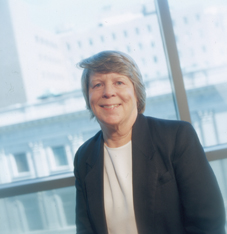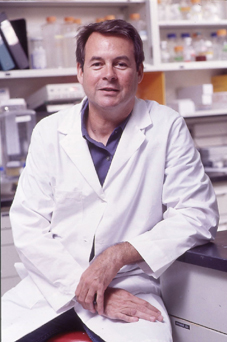Two from Johns Hopkins Elected to National Academy of Sciences
Two Johns Hopkins researchers were among 72 of the nation's top scientists elected today to membership in the National Academy of Sciences at the organization's 141st annual meeting in Washington, D.C.
Richard Huganir, PhD, professor of neuroscience and a Howard Hughes Medical Institute investigator at the Johns Hopkins School of Medicine, and Diane E. Griffin, MD, PhD, professor and chair of the W. Harry Feinstone Department of Molecular Microbiology and Immunology at the Johns Hopkins Bloomberg School of Public Health, join 15 other Johns Hopkins faculty members currently in the Academy, an honorary society that advises the government on scientific matters.
Dr. Griffin's research has focused on how viruses cause disease. For example, Sindbis virus, is transmitted by mosquitoes and causes encephalitis, an inflammation of the brain, in mammals and birds. She has studied how the virus infects and kills selected nerve cells in mice and has identified ways that the immune system can clear virus from neurons without harming them.
 Dr. Griffin also is investigating measles, a disease that continues to cause the deaths of a large number of children in developing countries. Through collaborations at a study site at University Teaching Hospital in Lusaka, Zambia, Griffin and her colleagues are trying to find out how measles virus infection suppresses the immune system, which can lead to serious secondary infections and even death. They've also discovered that measles infection suppresses replication of HIV, a phenomenon they continue to investigate. In addition, she is working to understand how the immune system protects people from infection and is using this knowledge to develop a new measles vaccine that would protect children younger than six months.
Dr. Griffin also is investigating measles, a disease that continues to cause the deaths of a large number of children in developing countries. Through collaborations at a study site at University Teaching Hospital in Lusaka, Zambia, Griffin and her colleagues are trying to find out how measles virus infection suppresses the immune system, which can lead to serious secondary infections and even death. They've also discovered that measles infection suppresses replication of HIV, a phenomenon they continue to investigate. In addition, she is working to understand how the immune system protects people from infection and is using this knowledge to develop a new measles vaccine that would protect children younger than six months.
Dr. Griffin is also director of the Malaria Research Institute at the Johns Hopkins Bloomberg School of Public Health, which is working to eradicate malaria.
Griffin received her bachelor's degree in biology from Augustana College in Rock Island, Ill., and her medical doctorate and PhD in immunology from Stanford University in 1968 and 1970, respectively. She conducted her medical residency at Stanford, and was a virology fellow at Johns Hopkins from 1970 until 1973, when she joined the faculty as an assistant professor of medicine and neurology. From 1975 until 1982, Griffin was an investigator of the Howard Hughes Medical Institute at Johns Hopkins. She advanced to associate professor of medicine and neurology in 1979, and in 1986 was named a full professor in these departments. In 1994, she also became professor and chair of Molecular Microbiology and Immunology in the School of Public Health.
Griffin is a Fellow of the American Association for the Advancement of Science and of the Infectious Disease Society of America. She is currently editor of the Journal of Virology and on the editorial boards of Virology, Virus Research and the Journal of Neurovirology. She has given numerous guest lectures and authored or co-authored more than 100 book chapters and review articles and more than 200 peer-reviewed journal articles.
 Dr. Huganir's research has focused on how molecular signals created and received by nerves in the brain allow learning and memory to take place.
Dr. Huganir's research has focused on how molecular signals created and received by nerves in the brain allow learning and memory to take place.
Scientists believe that learning and memory happen when communication channels between nerve cells are weakened or strengthened, a process called synaptic plasticity. For example, a burst of an excitatory chemical called glutamate from one nerve to the next will make it harder for that particular connection to "fire" again for a certain amount of time. The sheer number of possible connections gives the brain unfathomable flexibility -- each of the brain's trillion nerve cells can have up to a thousand connections to other nerves.
Huganir and his colleagues are investigating exactly how these nerve-to-nerve communications happen and what molecules are involved in weakening or strengthening two neurons' ability to talk to one another.
Last year, for example, Huganir and his colleagues discovered in experiments with mice a critically important step in storing new memories. When a phosphate group couldn't be hooked onto one part of the animal's glutamate receptor, the mice quickly forgot the location of a platform in a pool of water.
Also last year, Huganir and fellow neuroscience faculty member, David Linden, reported finding one of the last steps involved in weakening neurons' interactions. Their discovery offered the first way to test which proteins or genetic changes affect this weakening process.
Huganir received his bachelor's degree in biochemistry from Vassar College and his PhD from Cornell University's program in biochemistry, molecular and cell biology in 1982. He completed his postdoctoral training with Nobel laureate Paul Greengard, first at Yale and then at Rockefeller University, where he became an assistant professor in 1984. In 1988, he joined the faculty of the Johns Hopkins School of Medicine as an associate professor of neuroscience and of biological chemistry, and was named an associate investigator of the Howard Hughes Medical Institute. In 1993, he was named a professor of neuroscience and biological chemistry and an investigator of HHMI, positions he still holds.
Public Affairs Media Contacts for the Johns Hopkins School of Medicine: Joanna Downer at 410-614-5105 or jdowner1@jhmi.edu. Public Affairs Media Contacts for the Johns Hopkins Bloomberg School of Public Health: Tim Parsons or Kenna Brigham at 410-955-6878 or paffairs@jhsph.edu.